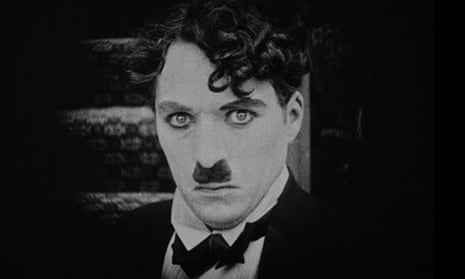Opening the Gotham hotel press conference for Monsieur Verdoux in 1947, Charlie Chaplin (1889-1977) told journalists to “proceed with the butchery”. I’d read that comment before, but in this expansive documentary the original audiotape is dramatised in the verbatim theatre style of Clio Barnard’s The Arbor, enabling us to see and hear it – sort of. As with their wonderful previous work Notes on Blindness (2016), co-directors James Spinney and Peter Middleton make adventurous use of lip-synced recreations, bringing old audio recordings to new cinematic life as they wrestle with the contradictory spectre of one of cinema’s true pioneers.
It’s a technique that proves particularly powerful when applied to the tape-recorded recollections of Effie Wisdom, a childhood friend of Chaplin’s who was interviewed by Kevin Brownlow in the early 80s, and who is here embodied on screen by Anne Rosenfeld. There’s something genuinely uncanny about the result, as if the film were conjuring ghosts to retell their stories – a feeling brought full circle thanks to a late-life meeting between the pair (“I said: ‘Well, Charlie, we’re all getting on, darling, aren’t we?’”). Affecting too is a wide-ranging interview Chaplin gave for Life magazine in 1966 – recorded for the page but here leaping from the screen.
From childhood poverty to adult stardom, obscurity to fame and then infamy, Chaplin’s story was always the stuff of legend. Yet unlike Richard Attenborough’s stodgy 1992 biographical drama, Chaplin, this documentary provides a gripping, clear-eyed overview of his life and works. When comparisons are made between real life and fiction (the attic room of Chaplin’s boyhood is juxtaposed with scenes from The Kid), such connections seem organic rather than contrived. An investigation of the phenomenon of Chaplin impersonators says as much about the “global village” aspect of moving pictures as it does about Chaplin’s own fame, with this magical new medium allowing the formerly theatre-bound Karno clown to appear in many locations at the same time.
Admittedly, Chaplin aficionados will find little that is new, and may be frustrated by the concertina-ing of his early work at Keystone, Essanay and Mutual. Things change in the United Artists era, particularly during an extended discussion of a scene from City Lights. Here, the complex process of constructing an apparently simple gag is vividly brought to life, with Pearl Mackie’s low-key narration astutely highlighting the irony of a silent film pivoting upon a car-door slam.
Chaplin’s co-star in City Lights was Virginia Cherrill, and their onscreen chemistry prompted speculation about real-life romance. Cherrill later commented that, at the age of 20, she was much too old for Chaplin, an observation that leads this documentary into well-rehearsed but still shocking accounts of his several marriages to (and affairs with) very young women. Much is made of how these women were silenced by Chaplin (his autobiography never even names the second of three teenage brides, Lita Grey) and exploited by his enemies (Hedda Hopper and the FBI both leapt on Joan Barry’s paternity suit), becoming little more than footnotes in the life of a troublesome “genius”. By a strange twist of fate, the one woman with whom Chaplin had a lengthy, stable relationship – his fourth wife, the actor Oona O’Neill – apparently left almost no recordings of her voice, leading her daughter to note forlornly that “my mother’s voice doesn’t exist”.
Marriages and divorces not only made headlines but also fuelled the anti-communist witch-hunts that drove the creator of the anti-fascist masterpiece The Great Dictator out of America. While Being the Ricardos is shaping up as leading Oscar contender, the red-scare tribulations recounted here are altogether more horrifying.
“Who is the real Charlie Chaplin?” asks the documentary, and the answer is: “Who knows?” Like the Little Tramp alter ego he constructed from absurdly contradictory castoffs (Ford Sterling’s size 14 shoes, Fatty Arbuckle’s giant trousers, Chester Conklin’s tight coat, Mack Swain’s cut-down moustache), he was the long and the short and the tall, all at once. In the words of writer Max Eastman: “Enjoy any Charlie Chaplin you have the good luck to encounter, but don’t try to link them up… There are too many of them.”
